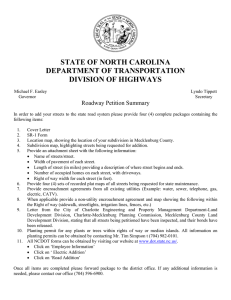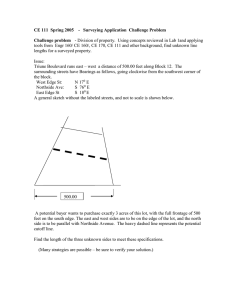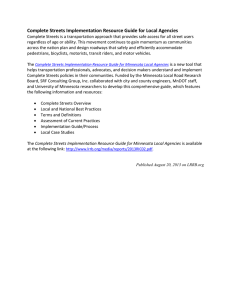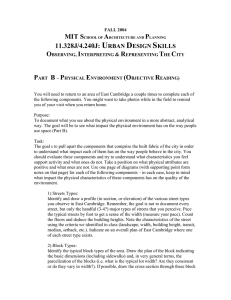Complete Streets Promote Good Health
advertisement
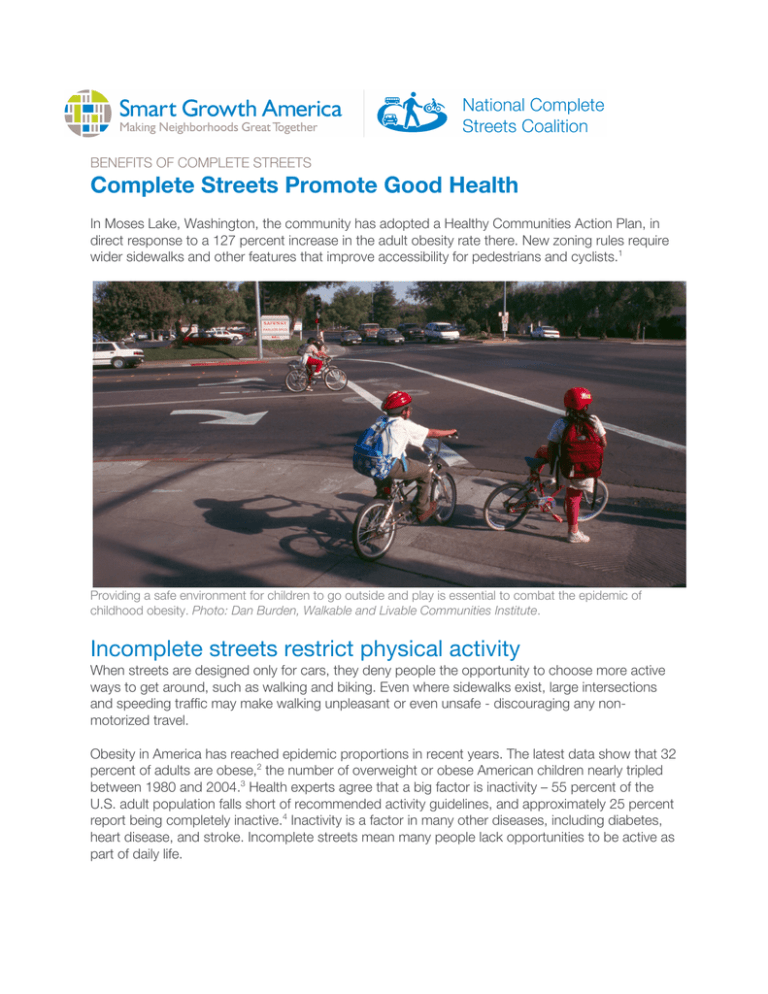
BENEFITS OF COMPLETE STREETS Complete Streets Promote Good Health In Moses Lake, Washington, the community has adopted a Healthy Communities Action Plan, in direct response to a 127 percent increase in the adult obesity rate there. New zoning rules require wider sidewalks and other features that improve accessibility for pedestrians and cyclists.1 Providing a safe environment for children to go outside and play is essential to combat the epidemic of childhood obesity. Photo: Dan Burden, Walkable and Livable Communities Institute. Incomplete streets restrict physical activity When streets are designed only for cars, they deny people the opportunity to choose more active ways to get around, such as walking and biking. Even where sidewalks exist, large intersections and speeding traffic may make walking unpleasant or even unsafe - discouraging any nonmotorized travel. Obesity in America has reached epidemic proportions in recent years. The latest data show that 32 percent of adults are obese,2 the number of overweight or obese American children nearly tripled between 1980 and 2004.3 Health experts agree that a big factor is inactivity – 55 percent of the U.S. adult population falls short of recommended activity guidelines, and approximately 25 percent report being completely inactive.4 Inactivity is a factor in many other diseases, including diabetes, heart disease, and stroke. Incomplete streets mean many people lack opportunities to be active as part of daily life. Post World War II growth patterns and street designs tend to favor the automobile over walking and bicycling. The health impacts are clear — one study found that, on a daily basis, each additional hour spent driving is associated with a 6 percent increase in the likelihood of obesity, while each additional kilometer walked is associated with a 5 percent reduction in this likelihood.5 When streets provide adequate access to bicyclists and joggers, being active is easy. Photos: Dan Burden, Walkable and Livable Communities Institute. Complete Streets make active living easy Complete Streets provide opportunities for increased physical activity by incorporating features that promote regular walking, cycling and transit use into just about every street. A report prepared by the National Conference of State Legislators found that the most effective policy avenue for encouraging bicycling and walking is incorporating sidewalks and bike lanes into community design – essentially, creating Complete Streets.6 The continuous network of safe sidewalks and bikeways provided by a Complete Streets policy is important for encouraging active travel. A comprehensive assessment by public health researchers of actions to encourage more physical activity recommended building more sidewalks, improving transit service, and shifting highway funds to create bike lanes.7 One study found that 43 percent of people with safe places to walk within 10 minutes of home met recommended activity levels; among those without safe places to walk just 27 percent met the recommendation.8 Residents are 65 percent more likely to walk in a neighborhood with sidewalks.9 Walkability has a direct and specific relation to the health of residents. A comprehensive study of walkability has found that people in walkable neighborhoods did about 35-45 more minutes of moderate intensity physical activity per week and were substantially less likely to be overweight or obese than similar people living in low-walkable neighborhoods.10 Easy access to transit can also contribute to healthy physical activity. Nearly one third of transit users meet the Surgeon General’s recommendations for minimum daily exercise through their daily travels.11 A community with a Complete Streets policy ensures streets are designed and operated to make it easy for people to get physical activity as part of their daily routine, helping them stay trim, avoid National Complete Streets Coalition 1707 L St. NW Suite 250 Washington, DC 20036 202-207-3355 heart disease, and receive the many other benefits of physical activity. DuPage County, Illinois adopted its Complete Streets policy as a health measure, calling it their “Healthy Streets Initiative” and the Tacoma-Pierce County Board of Health (WA) adopted a resolution urging decision makers in all Pierce County municipalities to adopt and implement Complete Streets policies to promote healthy living. Learn more at www.smartgrowthamerica.org/completestreets. 1 Centers for Disease Control and Prevention (2008). Preventing Chronic Diseases: Investing Wisely in Health. http://www.cdc.gov/nccdphp/publications/factsheets/prevention/pdf/obesity.pdf 2 U.S. CDC. (2006). “Physical Activity and Good Nutrition: Essential Elements to Prevent Chronic Disease and Obesity.” 3 U.S. CDC. (2004). “Physical Activity and the Health of Young People.” 4 U.S. Department of Health and Human Services. (2000). Healthy people 2010. 2nd edition. Washington, DC: U.S. Government Printing Office. 5 Frank, L.D., Andresen, M.A., and Schmid, T.L. (2004). “Obesity Relationships with Community Design, Physical Activity, and Time Spent in Cars.” American Journal of Preventative Medicine 27:2. 6 Teach Robbins, L., Morandi, L. (2002, December). Promoting Walking and Biking: the Legislative Role. National Conference of State Legislators. www.activelinvingleadership.org/pdf_file/Promoting_Walking_and_biking.pdf 7 Brennan-Ramirez, Laura K. et al. (2006). "Indicators of Activity-Friendly Communities: An Evidence-Based Consensus Process." American Journal of Preventive Medicine, Volume 31, Issue 6 8 Powell, K.E., Martin, L., & Chowdhury, P.P. (2003). “Places to walk: convenience and regular physical activity.” American Journal of Public Health, 93, 1519-1521. 9 Giles-Corti, B., & Donovan, R.J. (2002). “The relative influence of individual, social, and physical environment determinants of physical activity.” Social Science & Medicine, 54 1793-1812. 10 Sallis, James F, et al. (2009). “Neighborhood built environment and income: Examining multiple health outcomes.” Social Science and Medicine 68:1285-1293. 11 Besser, L. M. and A. L. Dannenberg. (2005). Walking to public transit steps to help meet physical activity recommendations. American Journal Of Preventive Medicine 29(4): 273-280. National Complete Streets Coalition 1707 L St. NW Suite 250 Washington, DC 20036 202-207-3355
